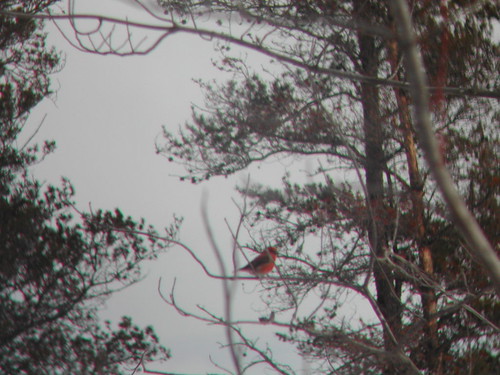Red Crossbill
(Loxia curvirostra)
Conservation • Description • Habitat • Ecology • Distribution • Taxonomy
Conservation Status |
|
|||||||
| IUCN Red List | LC - Least Concern |
|||||||
| NatureServe | N5 - Secure SNRB, SNRN - Unranked Breeding and Nonbreeding |
|||||||
| Minnesota | not listed |
|||||||
Description |
||
Red Crossbill is a common, colorful, medium-sized finch. It occurs in the temperate and subpolar regions of the Northern Hemisphere. In Minnesota it is most common in the Arrowhead region, especially in the fall. In the remainder of the state, it is occasional to rare. There are about 28 subspecies of Red Crossbill worldwide, 7 to 10 subspecies in the United States, and at least 1 subspecies in Minnesota. These numbers vary over time and depending on the source. New subspecies are still being defined as isolated populations diverge genetically. Adults feed mostly on conifer seeds, especially pine, but also spruce, fir, and hemlock. They also feed on buds, on seeds of deciduous trees, and occasionally on insects. They rarely visit bird feeders. Conifer seed production varies considerably from year to year. Red Crossbills are nomadic, not migratory. When food supply is scarce in their normal range, they move in great numbers, sometimes including thousands of birds. Their sporadic arrivals (irruptions) in northern Minnesota tend to coincide with bumper crops of conifer seeds in the state. In their normal range, Red Crossbills are found in coniferous and mixed forests and in conifer plantations. In winter and during travel outside of their normal range, they may also be found in deciduous forests, open shrubby areas, parks, and gardens. Adults are stocky, 5½″ to 7⅞″ (14 to 20 cm) in length, have a 10⅝″ to 11½″ (27 to 29 cm) wingspan, and weigh 0.8 to 1.6 oz. (23.7 to 45.5 g). The head is large. The bill is large and consists of an upper and lower mandible curved in opposite directions. It is inserted closed onto a pinecone, then opened to spread the scales and retrieve the seed. This is the feature that gives the genus its common name. On the male, the head, back, and undersides, including the throat, are dull brick red or orangish red. The wings and tail are dark brown. The tail is short. The female is similarly patterned, but is olive gray to yellow where the male is red. |
||
Size |
||
Length: 5½″ to 7⅞″ (14 to 20 cm) Wingspan: 10⅝″ to 117⁄16″ (27 to 29 cm) Weight: 0.8 to 1.6 oz. (23.7 to 45.5 g) |
||
Voice |
||
Similar Species |
||
Habitat |
||
Coniferous, mixed, and deciduous forests, conifer plantations, open shrubby areas, parks, and gardens |
||
Ecology |
||
Migration |
||
Red crossbills do not migrate, though they do wander far outside of their breeding range. |
||
Nesting |
||
|
||
Food |
||
Conifer seeds, buds, seeds of deciduous trees, and occasionally insects |
||
Distribution |
||||
Occurrence |
||||
|
||||
Maps |
||||
The Minnesota Ornithologists’ Union All Seasons Species Occurrence Map |
||||
Taxonomy |
|||
| Class | Aves (birds) | ||
Order |
Passeriformes (perching birds) | ||
Family |
Fringillidae (finches, euphonias, and allies) | ||
| Subfamily | Carduelinae | ||
Genus |
Loxia (crossbills) | ||
Subordinate Taxa |
|||
Altai Crossbill (Loxia curvirostra altaiensis) Balearic Crossbill (Loxia curvirostra balearica) Bendire's Crossbill (Loxia curvirostra bendirei) Central American Crossbill (Loxia curvirostra mesamericana) Corsican Crossbill (Loxia curvirostra corsicana) Crimean Crossbill (Loxia curvirostra mariae) Cyprus Crossbill (Loxia curvirostra guillemardi) Dalat Crossbill (Loxia curvirostra meridionalis) Himalayan Crossbill (Loxia curvirostra himalayensis) Japanese Crossbill (Loxia curvirostra japonica) Lesser Crossbill (Loxia curvirostra minor) Luzon Crossbill (Loxia curvirostra luzoniensis) Mexican Crossbill (Loxia curvirostra stricklandi) Newfoundland Red Crossbill (Loxia curvirostra percna) Newfoundland Red Crossbill (Loxia curvirostra pusilla) North African Crossbill (Loxia curvirostra poliogyna) Ponderosa Pine Crossbill (Loxia curvirostra benti) Sierra Crossbill (Loxia curvirostra grinnelli) Sitka Crossbill (Loxia curvirostra sitkensis) Tien Shan Crossbill (Loxia curvirostra tianschanica) West European Crossbill (Loxia curvirostra curvirostra) |
|||
Synonyms |
|||
|
|||
Glossary
Term
Definition
Visitor Photos |
|||||
Share your photo of this bird. |
|||||
| This button not working for you? Simply email us at info@MinnesotaSeasons.com. Attach one or more photos and, if you like, a caption. |
|||||
Bill Reynolds |
|||||
They came in today with a flock of Pine siskins, however the Crossbill numbers were small compared to the Siskins. I've heard others in the area spotting the Crossbills about a week ago, but it wasn't til today that I first spotted them at my feeders. The wind was blowing these ball shaped feeders all over, so a bit difficult to capture. I'll try again on a calmer day. |
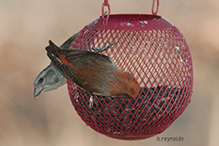 |
||||
I know these birds hang out in pine or evergreens forests, so am surprised to see them out here is the wide-open prairie area. The Woodlots in the area are primarily Popple, but in my yard with just a few evergreens stand. |
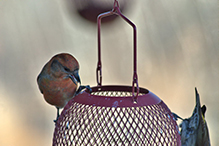 |
||||
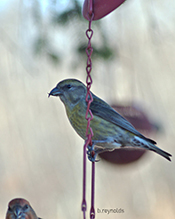 |
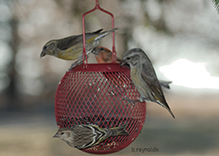 |
||||
MinnesotaSeasons.com Photos |
|||||
|
|||||

Visitor Videos |
|||
Share your video of this bird. |
|||
| This button not working for you? Simply email us at info@MinnesotaSeasons.com. Attach a video, a YouTube link, or a cloud storage link. |
|||
Other Videos |
|||
| Red crossbill (Loxia curvirostra) feeding from a spruce cone, Bavarian Forest National Park, Germany Nature Picture Library |
|||
About
May 7, 2019 Red crossbill (Loxia curvirostra) feeding from a spruce cone, Bavarian Forest National Park, Germany, October. ©Kerstin Hinze/naturepl.com |
|||
| Red crossbill flock of birds drinks water Wildlife World |
|||
About
Nov 10, 2018 Red crossbill. Flock of the birds drinks water. Loxia curvirostra. |
|||
| Mindre korsnäbb Crossbill (Loxia curvirostra) Naturfilm / WildlifeVideoPicture / Microcosmos |
|||
About
Dec 21, 2009 Filmad med Canon XL2 och Sigma 50-500. Björkäng Varberg Halland 2008-02-29 |
|||


Created: 12/11/2023
Last Updated:

